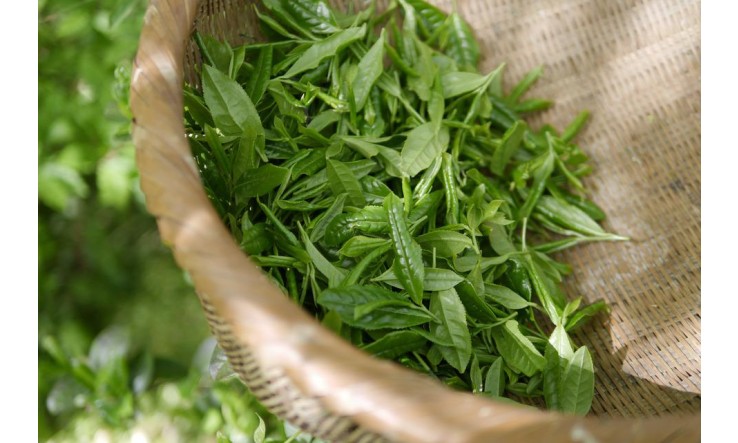
Green Tea & Skin Protection
What can cause skin damage?
- The skin is frequently exposed to a variety of environmental, chemical, and genotoxic agents that can lead to various pathologies. Ultraviolet (UV) light is the main external stressor that leads to immunosuppression, oxidative stress, premature aging, and tumor formation.1 Scientists and healthcare professionals emphasize the importance of prevention strategies to circumvent these unfavorable outcomes.
UV Rays - Protection Means
- Avoiding the sun, regularly using sunscreen, and wearing protective clothing are the most commonly recommended methods to prevent UV-induced damage.
Additional Photoprotection Strategy (Polyphenol - Catechin)
- Abundant and inexpensive, tea is an important dietary source of plant polyphenols and, after water, it is the second most consumed beverage in the world. Recent in vitro and in vivo studies, on animal and human skin, have shown its anti-inflammatory, antioxidant, photoprotective, and chemo preventive effects after topical application and oral consumption of green tea. 2,3,4
- A study was conducted to determine if the consumption of green tea could offer protection against UV rays to human peripheral blood cells collected after tea ingestion. A test was used to evaluate UV-induced DNA damage in peripheral leukocytes isolated from 10 adult human volunteers before and after drinking 7.5 mg of pure green tea infused in 540 ml of boiling water. The results of the trials demonstrated a photoprotective effect, with samples of peripheral blood cells taken after the consumption of green tea showing lower levels of DNA damage than those taken before ingestion when exposed to 12 minutes of ultraviolet A (UVA) radiation. 5,6
- Another study observed that regular intake of EGCG (epigallocatechin-3-gallate, the most abundant and studied catechin with powerful therapeutic effects on the skin) increased the minimum dose of radiation required to induce erythema, suggesting that EGCG is capable of enhancing skin tolerance by inhibiting UV-induced skin damage. Based on these results, it can be seen that orally consumed EGCG has two different mechanisms of action and can act both as a chemo preventive and photo chemo preventive agent; it can protect the body by suppressing, slowing down, and reversing the carcinogenesis process, as well as by protecting the skin from harmful radiation caused by harmful UVB rays. 7
- It is emphasized that dermatologists are significantly interested in green tea polyphenols as preventive products for skin cancer, as their use has shown promising results. 8
References:
1.Wang L, Shirure VS, Burdick MM, Wu S. UVB-irradiation regulates VLA-4-mediated melanoma cell adhesion to endothelial VCAM-1 under flow conditions. Mol Carcinog. 2011 Jan;50(1):58-65. doi: 10.1002/mc.20696 PMID: 21061269. PMCID: PMC3031905 DOI: 10.1002/mc.20696 https://pubmed.ncbi.nlm.nih.gov/21061269/
2. H N Graham. Green tea composition, consumption, and polyphenol chemistry. Prev Med 1992 May;21(3):334-50. doi: 10.1016/0091-7435(92)90041-f. PMID: 1614995 DOI: 10.1016/0091-7435(92)90041-f https://pubmed.ncbi.nlm.nih.gov/1614995/
3. Susan L Walker, Antony R Young. An action spectrum (290-320 nm) for TNFalpha protein in human skin in vivo suggests that basal-layer epidermal DNA is the chromophore. Proc Natl Acad Sci USA. 2007 Nov 27;104(48):19051-PMID: 18025480. PMCID: PMC2141906. DOI: 10.1073/pnas.0703385104. https://pubmed.ncbi.nlm.nih.gov/18025480/
4.Patricia OyetakinWhite, Heather Tribout and Elma Baron. Protective Mechanisms of Green Tea Polyphenols in Skin, Oxid Med Cell Longev. Published online 2012 Jun 26. doi: 10.1155/2012/560682 PMCID: PMC3390139, PMID: 22792414 https://www.ncbi.nlm.nih.gov/pmc/articles/PMC3390139/pdf/OXIMED2012-560682.pdf
5.Helena Malhomme de la Roche, Susan Seagrove, Anisha Mehta, Preshita Divekar, Sandra Campbell, Alison Curnow. Using natural dietary sources of antioxidants to protect against ultraviolet and visible radiation-induced DNA damage: an investigation of human green tea ingestion. J Photochem Photobiol B. 2010 Nov 3;101(2):169-73. doi: 10.1016/ j. jphotobiol. 2010.04.006. Epub 2010 Apr 20. https://pubmed.ncbi.nlm.nih.gov/20452781/
6. Nick Morley, Tim Clifford, Leo Salter, Sandra Campbell, David Gould, Alison Curnow. The green tea polyphenol (-)-epigallocatechin gallate and green tea can protect human cellular DNA from ultraviolet and visible radiation-induced damage. Photodermatol Photoimmunol Photomed. 2005 Feb;21(1):15-22. doi: 10.1111/j.1600-0781.2005.00119. x. https://pubmed.ncbi.nlm.nih.gov/15634219/
7. Joi A Nichols, Santosh K Katiyar. Skin photoprotection by natural polyphenols: anti-inflammatory, antioxidant and DNA repair mechanisms. Arch Dermatol Res. 2010 Mar;302(2):71-83. doi: 10.1007/s00403-009-1001-3. Epub 2009 Nov 7. https://pubmed.ncbi.nlm.nih.gov/19898857/
8.Y D Jung, L M Ellis. Inhibition of tumour invasion and angiogenesis by epigallocatechin gallate (EGCG), a major component of green tea. Int J Exp Pathol 2001 Dec;82(6):309-16. doi: 10.1046/j.1365-2613.2001.00205. x. https://pubmed.ncbi.nlm.nih.gov/11846837/
Warning: The content of this article is published for informational purposes only and cannot be considered personalized medical advice. No treatment should be undertaken based solely on the content of this article, and it is strongly recommended that the reader consults healthcare professionals for any questions related to their health and well-being. None of the information or products mentioned on this site are intended to diagnose or treat any disease.



